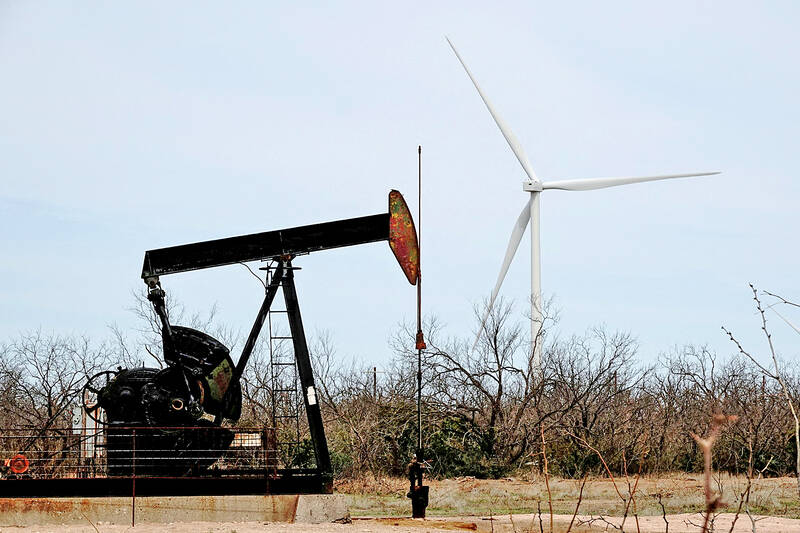Global oil demand in the first half of this year grew at its slowest pace since 2020 due to China’s economic slump, the International Energy Agency (IEA) said yesterday, prompting the agency to lower its full-year forecast.
Demand increased by 800,000 barrels per day (bpd) in the first six months of this year, compared with 2.3 million bpd over the same period last year, the IEA said in its monthly oil market report.
“The chief driver of this downturn is a rapidly slowing China, where consumption contracted y-o-y [year-on-year] for a fourth straight month in July,” the Paris-based agency said.

Photo: Reuters
China is among the world’s top consumers and importers of oil, but the world’s second-biggest economy has struggled amid weak consumer spending, a property sector crisis and high unemployment.
The IEA also cited the country’s shift away from oil in favor of alternative energy.
Rising sales of electric vehicles are reducing demand for road fuel, while the development of its vast high-speed rail network is restricting growth in domestic air travel, the IEA said.
Outside of China, “oil demand is tepid at best,” it added.
For the full year, global oil demand is forecast to grow on average by 900,000 bpd, about 70,000 bpd below the IEA’s previous estimate.
That would take total demand to almost 103 million bpd.
Oil prices have weakened this year over concerns about the global economic outlook.
This week, Brent North Sea crude, the international benchmark, fell below US$70 per barrel for the first time since December 2021.
The fall in prices has prompted leading members of the OPEC+ oil cartel, including Saudi Arabia and Russia, to postpone a planned output increase and instead extend voluntary supply cuts until the end of November.
The IEA said the delay gives OPEC+ “some time to further evaluate demand prospects for next year,” as well as the impact of output disruptions in Libya.
However, with supply from non-OPEC+ nations rising faster than overall demand, the group “may be staring at a substantial surplus, even if its extra curbs were to remain in place,” it said.

Taiwanese suppliers to Taiwan Semiconductor Manufacturing Co. (TSMC, 台積電) are expected to follow the contract chipmaker’s step to invest in the US, but their relocation may be seven to eight years away, Minister of Economic Affairs J.W. Kuo (郭智輝) said yesterday. When asked by opposition Chinese Nationalist Party (KMT) Legislator Niu Hsu-ting (牛煦庭) in the legislature about growing concerns that TSMC’s huge investments in the US will prompt its suppliers to follow suit, Kuo said based on the chipmaker’s current limited production volume, it is unlikely to lead its supply chain to go there for now. “Unless TSMC completes its planned six

Intel Corp has named Tasha Chuang (莊蓓瑜) to lead Intel Taiwan in a bid to reinforce relations between the company and its Taiwanese partners. The appointment of Chuang as general manager for Intel Taiwan takes effect on Thursday, the firm said in a statement yesterday. Chuang is to lead her team in Taiwan to pursue product development and sales growth in an effort to reinforce the company’s ties with its partners and clients, Intel said. Chuang was previously in charge of managing Intel’s ties with leading Taiwanese PC brand Asustek Computer Inc (華碩), which included helping Asustek strengthen its global businesses, the company

Power supply and electronic components maker Delta Electronics Inc (台達電) yesterday said second-quarter revenue is expected to surpass the first quarter, which rose 30 percent year-on-year to NT$118.92 billion (US$3.71 billion). Revenue this quarter is likely to grow, as US clients have front-loaded orders ahead of US President Donald Trump’s planned tariffs on Taiwanese goods, Delta chairman Ping Cheng (鄭平) said at an earnings conference in Taipei, referring to the 90-day pause in tariff implementation Trump announced on April 9. While situations in the third and fourth quarters remain unclear, “We will not halt our long-term deployments and do not plan to

The New Taiwan dollar and Taiwanese stocks surged on signs that trade tensions between the world’s top two economies might start easing and as US tech earnings boosted the outlook of the nation’s semiconductor exports. The NT dollar strengthened as much as 3.8 percent versus the US dollar to 30.815, the biggest intraday gain since January 2011, closing at NT$31.064. The benchmark TAIEX jumped 2.73 percent to outperform the region’s equity gauges. Outlook for global trade improved after China said it is assessing possible trade talks with the US, providing a boost for the nation’s currency and shares. As the NT dollar